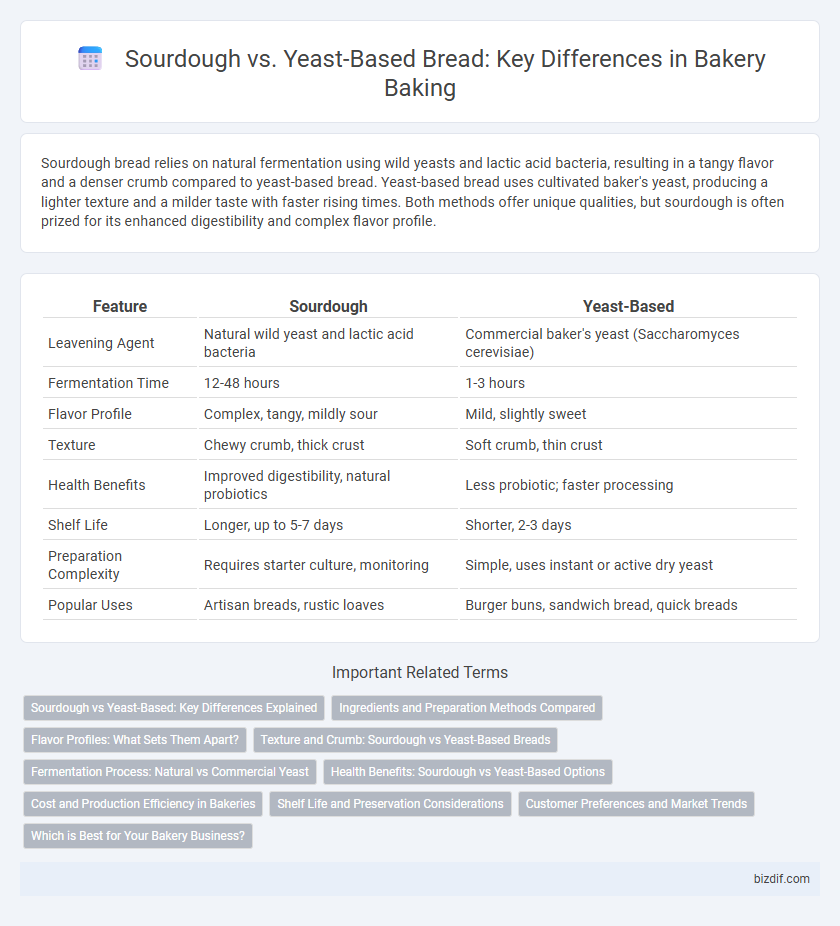Sourdough bread relies on natural fermentation using wild yeasts and lactic acid bacteria, resulting in a tangy flavor and a denser crumb compared to yeast-based bread. Yeast-based bread uses cultivated baker's yeast, producing a lighter texture and a milder taste with faster rising times. Both methods offer unique qualities, but sourdough is often prized for its enhanced digestibility and complex flavor profile.
Table of Comparison
| Feature | Sourdough | Yeast-Based |
|---|---|---|
| Leavening Agent | Natural wild yeast and lactic acid bacteria | Commercial baker's yeast (Saccharomyces cerevisiae) |
| Fermentation Time | 12-48 hours | 1-3 hours |
| Flavor Profile | Complex, tangy, mildly sour | Mild, slightly sweet |
| Texture | Chewy crumb, thick crust | Soft crumb, thin crust |
| Health Benefits | Improved digestibility, natural probiotics | Less probiotic; faster processing |
| Shelf Life | Longer, up to 5-7 days | Shorter, 2-3 days |
| Preparation Complexity | Requires starter culture, monitoring | Simple, uses instant or active dry yeast |
| Popular Uses | Artisan breads, rustic loaves | Burger buns, sandwich bread, quick breads |
Sourdough vs Yeast-Based: Key Differences Explained
Sourdough bread relies on natural fermentation using wild yeast and lactic acid bacteria, resulting in a tangy flavor and chewy texture, while yeast-based bread uses commercial baker's yeast for faster rising and a milder taste. The fermentation process in sourdough enhances nutrient absorption and creates a longer shelf life, contrasting with the quicker production but shorter freshness of yeast-based bread. Understanding these differences helps bakers select the appropriate method for desired flavor, texture, and health benefits.
Ingredients and Preparation Methods Compared
Sourdough bread relies on natural wild yeast and lactic acid bacteria from a fermented starter, while yeast-based bread uses commercial baker's yeast for faster fermentation. Sourdough preparation involves lengthy fermentation periods of 12 to 48 hours, enhancing flavor and digestibility, whereas yeast-based methods typically require 1 to 3 hours for dough to rise. Key ingredients for sourdough include flour, water, and the starter culture, contrasting with yeast-based recipes that often incorporate added sugars and fats to accelerate yeast activity and improve texture.
Flavor Profiles: What Sets Them Apart?
Sourdough bread features a complex, tangy flavor resulting from natural fermentation of wild yeast and lactic acid bacteria, creating a slightly sour and robust taste. Yeast-based bread offers a milder, sweeter flavor profile due to commercial yeast fermentation, which produces a more predictable and consistent rise. The distinct microbial activity in sourdough contributes to its depth of flavor, while yeast-based bread emphasizes softness and subtle sweetness.
Texture and Crumb: Sourdough vs Yeast-Based Breads
Sourdough bread features a denser, chewier texture with an open crumb structure characterized by irregular holes, resulting from natural fermentation by wild yeast and lactic acid bacteria. Yeast-based breads typically have a softer, fluffier texture with a finer, more uniform crumb due to commercial yeast's rapid fermentation. The slow fermentation process in sourdough enhances flavor complexity and moisture retention, contributing to its distinct mouthfeel compared to the lighter, more airy yeast-based varieties.
Fermentation Process: Natural vs Commercial Yeast
Sourdough relies on a natural fermentation process using wild yeast and lactic acid bacteria, which develop complex flavors and improved digestibility over time. Yeast-based bread utilizes commercial baker's yeast, providing a faster and more predictable rise with a milder taste. The distinct microbial activity in sourdough enhances antioxidant levels and can contribute to a lower glycemic index compared to yeast-based breads.
Health Benefits: Sourdough vs Yeast-Based Options
Sourdough bread undergoes a natural fermentation process that enhances the bioavailability of nutrients and introduces beneficial probiotics, aiding digestion and gut health. Yeast-based bread, while quicker to produce, lacks the same level of fermentation, resulting in fewer health-promoting properties and a higher glycemic index. Choosing sourdough can support better blood sugar control and improved nutrient absorption compared to conventional yeast-based options.
Cost and Production Efficiency in Bakeries
Sourdough bread involves longer fermentation times and requires skilled labor, resulting in higher production costs compared to yeast-based bread, which ferments faster and allows for larger batch production. Yeast-based dough reduces overhead expenses due to its predictable rise time and compatibility with automated baking equipment, increasing overall bakery efficiency. While sourdough offers premium product appeal, yeast-based methods optimize cost-effectiveness and scalability in commercial bakery operations.
Shelf Life and Preservation Considerations
Sourdough bread's natural fermentation produces lactic acid, which acts as a preservative and extends shelf life by inhibiting mold growth compared to yeast-based bread. Yeast-based bread typically has a softer texture but a shorter shelf life due to higher moisture content and lack of organic acids. Proper storage for both types includes keeping bread in a cool, dry place and avoiding plastic bags that trap moisture and accelerate spoilage.
Customer Preferences and Market Trends
Sourdough bread appeals to customers seeking natural fermentation, complex flavors, and artisanal quality, driving a growing market trend favoring traditional baking methods. Yeast-based bread remains popular for its consistent rise, softer texture, and quicker production time, catering to convenience-driven consumers. Current market analysis shows a rising demand for sourdough in premium bakery segments, while yeast bread dominates mass-market shelves due to affordability and shelf stability.
Which is Best for Your Bakery Business?
Sourdough offers a natural fermentation process that enhances flavor complexity and improves shelf life, making it ideal for artisanal bakeries targeting health-conscious customers. Yeast-based bread provides faster proofing and consistent results, perfect for high-volume production and businesses prioritizing efficiency. Choosing between sourdough and yeast-based depends on your bakery's business model, customer preferences, and production capacity.
Sourdough vs Yeast-Based Infographic

 bizdif.com
bizdif.com